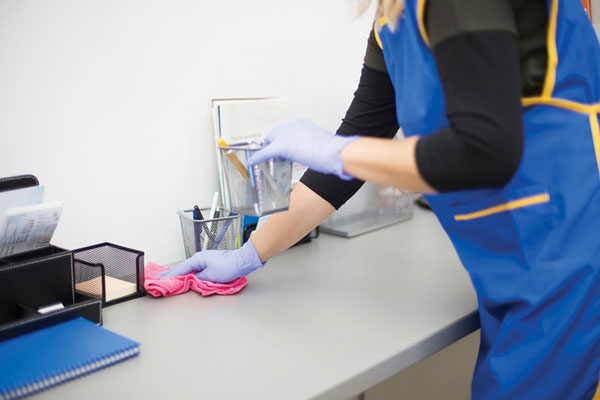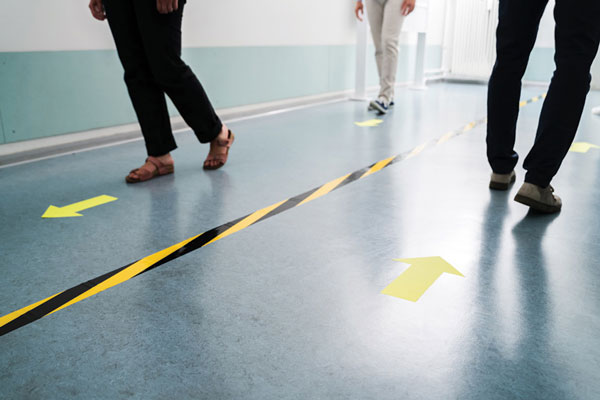Rethinking Real Estate: The Office of the Future

Safety, health and wellness in buildings and workplaces may become as important over the next 10 years as LEED certification has been over the past decade.
Cool, transit-rich urban office projects of the future and their suburban counterparts will offer tenant-attracting amenities and design, but what may actually close the deal will be the safety, health and wellness features of the building. That’s according to recent interviews with office developer/owners who are on the front lines of making their projects safe places to work.
Getting Offices Open
Health and safety concerns about COVID-19 drove people out of their offices to isolate at home in February and March. Alleviating those concerns will help encourage people to eventually return to these workplaces, according to the developers and owners. They are currently focused on efforts to build office-user confidence by implementing screening procedures for visitors, employees and contractors; creating staggered work times and lunch times to ease the burden on elevators; continually cleaning facilities, buttons and doorknobs; making elements in the building as touchless as possible; encouraging social distancing in every public area of the building, specifically lobbies and elevators; improving air quality; adding safety- and health-related signage; and much more.

High-touch areas in offices will be a critical focus of cleaning and sanitation efforts as workers return to buildings. Getty Images
Remote teams have demonstrated productivity, so large companies are not in a hurry to send their employees back to the office. Some tech firms want their people to return to the office by January 2021, but Google may have set the standard by recently announcing that its 200,000 employees can continue to work from home until the summer of 2021.
Nevertheless, developer/owners are preparing facilities for the eventual return of workers. According to Michael McNerney, executive vice president with Lowe Enterprises Real Estate Group in San Diego, there are three phases to getting offices open.
“The current phase is a reactive phase to get people to feel better and safer about coming into the office,” he said. “The second phase is about cost-effective retrofits that can be done to existing buildings to make them safer. The third phase is looking at the things that can be done to give people a greater comfort level and greater flexibility going forward.”
Not every office building is completely deserted at this point. McNerney pointed out that people were returning to its Denver building earlier than in other parts of the country.
“We’ve gotten good feedback from tenants there,” he said. “It comes down to clear communication with tenants. We are letting them know that we are doing everything we can to make the building safe and to help them feel safe about returning to work.”
Suburban office projects will probably open up before urban office buildings, said Paul F. Ciminelli, president and CEO of Ciminelli Real Estate Corp., in Buffalo, New York.
“People can come and go to the suburban office in cars,” he said. “In a city, many office users depend on mass transit to get them around, which is a big concern to people right now.”
Richard S. Gottlieb, president and CEO of Keystone Property Group in Conshohocken, Pennsylvania, said his firm is making the common areas in buildings as clean and comfortable as possible.
“We have signage, we watch the elevators, we clean all the time with sanitizer, but until there is a vaccine, I don’t think people will feel 100% comfortable [working at an office],” he said.
For the office buildings of the future, lobbies are an uncertain area in the post-COVID world, according to Collin E. Barr, Central U.S. president for the Ryan Companies US, Inc., in Minneapolis.
“We will have to see how post-COVID life transitions,” he said. “We are all hopeful that we will all be able to go out and socialize. If we continue to get hit by wave upon wave of these diseases, then I would surmise that some amenities such as the office building lobby will be turned into private office space, not amenities space, because people will not be willing to use it.”
Is Working from Home the Future?
The office of the future could be an employee’s kitchen table — or maybe not. Working from home is likely not the wave of the future for most people, according to a recent survey by Gensler. It found that only 12% of U.S. workers want to work from home full time. Most want to get back to the office, but have flexibility. The developers interviewed estimate that one or two days a week working from home and three to four days at the office would satisfy most people.
“Working from home or working in the office is not a one-size-fits-all concept,” said Ciminelli. “There are many hybrid forms of this arrangement. It could mean that certain people do not come in on Fridays or perhaps everyone comes in just four out of five days a week.”
Gottlieb said that remote working has been successful for many companies. People can work at home one or two days a week and be highly productive, but a study published in July from software firm Aternity shows that if people work at home more than two days a week, productivity tends to drop.
Does working from home help or hinder work-life balance? According to Gottlieb, work-life balance gets more out of whack if one telecommutes all the time because the fragile line between work and personal life becomes blurred.
“If someone at work wants to have a meeting with you at noon, they don’t care if you want to have lunch with your husband or wife,” he said. “If they want to reach you at 10 p.m., they will assume that you are right there.”
Safety and Wellness in Buildings of the Future
While the sleek office tower and workplace of the future will look and feel a lot like the office tower of today, the guts of the building will feature key safety and wellness equipment, Barr said. The HVAC systems in new and retrofitted buildings will be an effective barrier to keep disease transmission at a minimum. The same goes for materials used in office space. Barr anticipates antimicrobial materials — now used in medical office settings and hospitals — will be installed throughout offices to kill viruses and microbes.
“These changes will cost a lot of money,” he said. “But these are changes that tenants will value.”
Developer/owners are making quick fixes to HVAC systems to cut down on the transmission of the virus. Long-term, many systems will have to be replaced and upgraded at considerable cost.

One-way foot traffic patterns are already commonplace in many public spaces. They will also become common in offices. Getty Images
"There are a number of next steps that our company is looking into regarding air filtration systems and being able to kill germs at the source of the incoming fresh air,” said Gregory P. Fuller, president and COO of Granite Properties, Inc., in Plano, Texas. His company recently announced an initiative to invest more than $10 million across its portfolio to improve air quality and add more touchless technology. “An effective way to do this is with MERV 13. MERV 13 filters trap virus particles. Using MERV 13 filters in conjunction with a bipolar ionization unit at the HVAC unit will kill germs. We will do that in all of our buildings.”
MERV stands for Minimum Efficiency Reporting Value. It’s a scale developed by the American Society of Heating, Refrigerating and Air-Conditioning Engineers (ASHRAE) to show how well filters can remove particles of different sizes. The bigger the MERV number, the smaller the particles that can be captured.
Bipolar ionization systems, which are specialized tubes added to HVAC equipment, release charged atoms that can deactivate harmful substances like viruses. In-duct UV lights, ultraviolet lights placed inside the ductwork of an HVAC system, kill germs and viruses before they are pushed into occupied space by the air flow. Fuller said that not every building can utilize MERV 13 filters because they require a large amount of fresh air. Buildings constructed in the 1980s and 1990s were not designed to handle that much air flow. If a code requires that a building needs 30% to 40% fresh air intake, those old buildings would not meet the requirements.
“In those buildings, however, you can do bipolar ionization and in-duct UV light,” he said. “So there are workarounds for older buildings that require less than tearing out the entire building. Even in an elevator cab, you can install a bipolar ionization unit. The downside is that if someone gets on the elevator who is sick, there is a chance of transmitting the virus because these units do not kill a virus instantly.”
TI Costs Likely to Jump
Installing tenant improvements in the office of the future will likely cost more, according to Barr. No one will be able to simply move into a previously occupied office, lay down carpet and paint the walls.
“They will need to rip out all the drywall, probably a lot of the HVAC and the electrical system,” he said. “Additionally, they’re going to want more private office spaces that can be shared. There will be greater investment in workstations as well.”
Barr said in pre-COVID offices, eight people could be squeezed into a 16-foot-by-16-foot quad, but that simply won’t work anymore.
Coworking Space Viability
What’s ahead for coworking office space? Will it stay, go or change? It will likely stay in some form.
Ciminelli expects coworking space to come back strongly once the pandemic has passed.
“We have coworking space in our buildings, and we are a big fan of it,” he said. “I prefer our model, where we own the coworking space, control it and use it as a building amenity vs. the WeWork model. Moving forward, coworking will be beneficial because office users will have a greater need for flexibility.”
Ryan Companies had considered a number of anchor tenants for coworking space and ended up not doing it, according to Barr.
“Coworking stations [of the future] will be a different configuration than today with larger workstations that have three or four sides,” he said. “There will be less of a wide- open environment.”
McNerney suggested that coworking will need to confront the same issue as every other space user in a post-COVID world.
“You will need more space between people, better building air filtration and touchless technology,” he said.
Large Office Footprint
In the office of the future, will large companies continue to occupy huge office footprints or will they spread employees out into a number of satellite offices? Most of those interviewed agreed that large companies would want to keep people together in a big facility. But some see a future where companies might go with a different arrangement.
“There may be a lot of hub-and-spoke arrangements where you have a mothership office and then you have a lot of smaller offices,” said McNerney. “It would add to flexibility for employees. That is, people may not want to work from home all of the time, but they may prefer to work at a small satellite office rather than commuting to the main office.”
What Lenders Will Look For
What will lenders and investors look for in a post-COVID office investment?
“Institutional investors will look more at what a building is doing from a health and wellness perspective,” said Fuller. “They will want to know what will attract customers to the building now and in the future. Lenders, on the other hand, will look at whether or not the building will have an income stream. Lenders are cautious right now because they do not know what the next six months will bring.”
Tech’s Role in the Future Office
Technology has played a starring role in the COVID-19 crisis and will continue to do so in the future. Companies told their employees to take their laptops home on a Friday afternoon in February or March to work remotely. On Monday morning, the home-based team members were up and running on Zoom, Webex, GoToMeeting or similar software.
Employees have adjusted well to Zoom, according to Gottlieb. While the virtual meeting will continue once employees return to work, these gatherings will be different than in the past. People may choose to stay away from stuffy, cramped conference rooms and instead meet virtually at their desks with other team members — in the office and working remotely.
Facility apps of every stripe will play a big role in the office of the future.
“Any time you have change in the world, technology usually fills the void,” said Fuller.
For example, Ciminelli was impressed with the technology he saw at a building he recently visited in Vancouver, British Columbia.
“One of the new high rises downtown has been designed with smart technology where you as a tenant in the building have an app that automatically gets you through security and to the destination elevators that drop you off at the floor you need to go to,” he said. “The app can track you anywhere you are in the building. So I think there will be more enhanced technology and buildings will be designed even smarter from a public health standpoint.”
Ron Derven is a contributing editor to Development magazine.
Changes Coming to the OfficeWhile the office of the future may have the look and feel of the office of today, big changes will come to make these structures safer and healthier. Here is what to expect: Office surfaces. Walls, countertops and other surfaces will be made of anti-microbial materials that are used today in hospitals and other medical facilities to reduce the possibility of getting sick. Virtual meetings. Most stay-at-home employees are meeting virtually today. When they return to work sometime in the future, rather than crowding into a stuffy conference room for a meeting, they will continue to meet virtually. In-office or remote, many meeting attendees will meet on the small screen. Work stations. Instead of typical 4-foot-by-3-foot work areas, the office of the future will furnish more space per person, perhaps 6 feet by 6 feet or even 6 feet by 8 feet. Rather than a single panel at the work station, there will be three panels to give the user more protection from those sitting nearby. Shared private offices. Look for more private offices that can be shared by different employees who need to make a private phone call or meet one-on-one while properly social distancing. Collaborative space. Break-out and conference spaces will be much like they were before with little opportunity to social distance in those areas. Coworking space. The WeWork coworking model may not be optimal in the future, but building owners and managers will continue to offer flexible spaces in buildings that they manage. Greater employee flexibility. After many companies discovered that their teams can work well remotely, employees will likely seek more flexibility for remote and in-office work. Building lobbies. The lobbies in new and retrofitted office buildings may or may not be used as they were in the past, depending on how comfortable office users feel in the space. Touchless technology. Common areas will become as touchless as Doorless restrooms. Restroom entrances in office buildings will have no doors, similar to those in airport terminals. Better building ventilation. Older buildings may be retrofitted with better HVAC systems, and new buildings will likely be fitted out with state-of-the-art equipment. |
Relevant NAIOP ResearchThe NAIOP Research Foundation recently released three research briefs that can help developers and owners make sense of the market in the wake of COVID-19. “Using Capital Improvements to Create Competitive Advantage in the COVID-19 Era” by Dustin C. Read, Ph.D./J.D., Associate Professor, Virginia Tech and Sam Kuprianov, undergraduate Real Estate major, Virginia Tech. This brief evaluates the merits of frequently discussed capital investments and their potential to create durable competitive advantages. It draws from an analysis of recent coverage in commercial real estate trade publications, as well as conversations with seven industry practitioners that took place in June 2020. “Navigating a Safe Return to Work: Best Practices for U.S. Office Building Owners and Tenants” by Shawn Moura, Ph.D., Director of Research for NAIOP. Measures to contain the coronavirus outbreak temporarily slowed economic activity and dramatically reduced occupancies at many commercial buildings. As state and local governments outline plans for a phased reopening of the economy, office building owners and employers are formulating plans that will allow employees to return safely to work. “Working Together as a Team: Negotiating With Tenants and Leasing Space During COVID-19,” also by Moura. This research brief draws from interviews with brokers and building owners, news sources, NAIOP webinars and NAIOP survey data to identify best practices for triaging office and industrial tenant requests, offering reasonable accommodations to those tenants who need short-term assistance, and responding to uncooperative tenants. The brief also examines how owners are adapting the ways they show and lease space to new tenant preferences and safety expectations. To view and download the reports, visit www.naiop.org/Research-and-Publications/Research-Reports |




